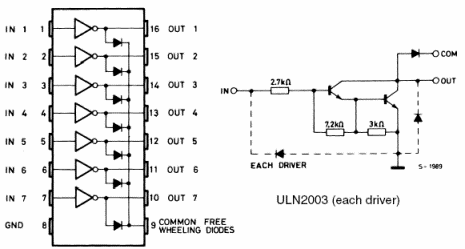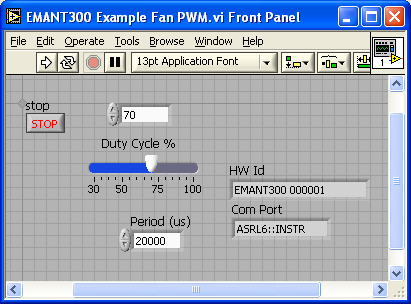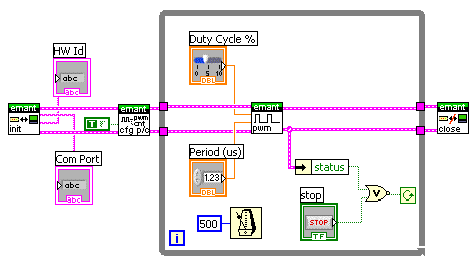DC Fan Speed Control
 Using Pulse-width modulation (PWM), the fan's power supply is turned on and off at a fixed frequency. By changing the duty-cycle, we control the speed
of the fan. The larger the duty cycle, the faster the fan spins. Typical frequencies range from 20Hz to 160Hz.
Using Pulse-width modulation (PWM), the fan's power supply is turned on and off at a fixed frequency. By changing the duty-cycle, we control the speed
of the fan. The larger the duty cycle, the faster the fan spins. Typical frequencies range from 20Hz to 160Hz.
The advantages of PWM include a very simple drive circuit, good startup characteristics, and minimal heat dissipation in the switching transistor. The disadvantages involve increased stress on the fan and the inability to use on board speed or alarm sensors.
However we cannot drive the fan directly from the EMANT300 Digital or PWM Output because
- the current needed to drive the motor is greater than the 20mA allowed by Digital or PWM Output
- the fan supply voltage may be greater than the 5V allowed by Digital or PWM Output eg a 12V fan
We recommend using the ULN2003 to drive the DC Fan. The ULN20031 is a high voltage, high current darlington array each containing seven open collector darlington pairs with common emitters. Each open collector darlington is rated at 500 mA.. It can accept output voltages of up to 50V. Suppression diodes are included for inductive load driving. The ULN2003 has 5V TTL, CMOS inputs and allows it to be connected directly to the EMANT300 Digital and PWM outputs.

Fig 1: ULN2003 schematic

Fig 2: Connecting the DC Fan to the EMANT300 using the ULN2003
Figure 2 shows how to connect the DC Fan to the EMANT300. The PWM output of the EMANT300 is connected to pin 5 of the ULN2003 and the corresponding output pin 12 is connected to the DC Fan. If you require only to turn on and off the fan, you may use the D0 output of the EMANT300 instead. You may also use any of the other open collector darlington pairs.
LabVIEW Front Panel

LabVIEW Block Diagram

Reference
- ULN2003 Seven Darlington Array Specification from STMicroelectronics